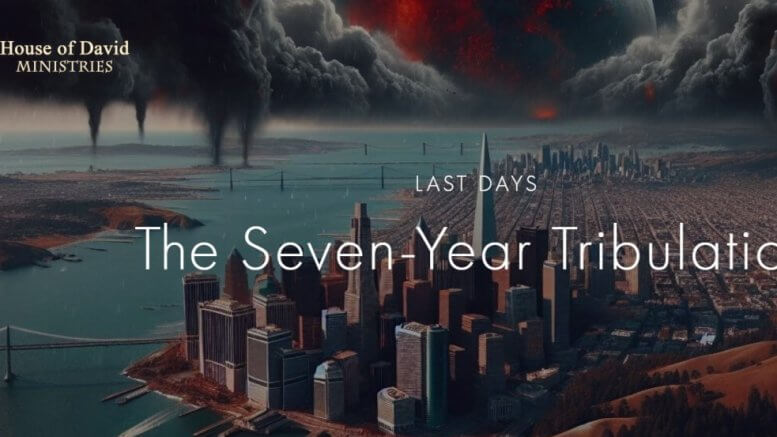Playback speed:
When the disciples asked Jesus, “What will be the sign of Your coming, and of the end of the age?” (Matthew 24:3), His answer pointed them not to peace or revival but to tribulation and cosmic upheaval. He said, “Immediately after the tribulation of those days the sun will be darkened, and the moon will not give its light; the stars will fall from heaven” (Matthew 24:29). Notice carefully — Jesus locates these signs after a great tribulation, not before.
In his recent article, “The Seven-Year Tribulation” published on The House of David, Pastor Eric Michael Teitelman explores this pivotal subject by grounding it firmly in Daniel’s prophecy and the broader sweep of Scripture. His analysis sheds much-needed light on a doctrine often neglected or misunderstood in today’s pulpits.
Daniel’s Seventy Weeks and the Final Seven Years
The starting point for understanding the Seven-Year Tribulation is Daniel 9:24–27. Here, the angel Gabriel outlines seventy “weeks” (literally “sevens”), which represent 490 years of God’s dealings with Israel:
“Seventy weeks are determined for your people and for your holy city,
to finish the transgression, to make an end of sins,
to make reconciliation for iniquity, to bring in everlasting righteousness,
to seal up vision and prophecy, and to anoint the Most Holy.” (Daniel 9:24)
Sixty-nine of these weeks (483 years) were fulfilled in history — from the rebuilding of Jerusalem (Nehemiah’s day) to the coming and crucifixion of Messiah (Daniel 9:25–26). Yet one week remains, a final seven-year period that has not yet been fulfilled.
This “seventieth week” is what Jesus refers to as the “great tribulation” (Matthew 24:21), what Jeremiah calls “the time of Jacob’s trouble” (Jeremiah 30:7), and what John describes in Revelation (chapters 6–19).
Israel at the Center of Prophecy
Contrary to popular theological systems such as Preterism, Amillennialism, or Post-Millennialism — all of which spiritualize or dismiss Israel’s future — Scripture consistently affirms that the Seven-Year Tribulation is God’s final dealing with national Israel.
-
Paul writes: “Blindness in part has happened to Israel until the fullness of the Gentiles has come in. And so all Israel will be saved” (Romans 11:25–26).
-
Ezekiel prophesies: “I will not hide My face from them anymore; for I shall have poured out My Spirit on the house of Israel” (Ezekiel 39:29).
We would appreciate your donation. -
Jesus Himself declared to Jerusalem: “You shall see Me no more till you say, ‘Blessed is He who comes in the name of the Lord!’” (Matthew 23:39).
In other words, God’s covenant with Israel has not been replaced by the church, nor has prophecy already been fulfilled in AD 70. The Seven-Year Tribulation is future, literal, and inseparable from Israel’s restoration.
The Danger of Confusing Voices in the Pulpit
Not every pulpit today proclaims this truth. Some voices claim that the Seven-Year Tribulation does not exist, that the resurrection happens only once “at the last day,” or that Israel has no prophetic future. Others dismiss the rapture as escapism.
But Scripture is clear:
-
Daniel 9:27 points to a future covenant broken by the Antichrist.
-
Revelation 20 distinguishes the first resurrection from the final judgment.
-
Romans 11 promises Israel’s future salvation.
-
1 Thessalonians 4:13–18 describes the church being “caught up” to meet the Lord.
Such teaching is not speculation; it is the plain testimony of the Word of God. Christians must guard against pulpits that confuse or spiritualize away prophecy, leaving believers uncertain about the hope of Christ’s return.
Why This Matters for the Church
Many Christians assume that because Christ warned of tribulation in general (John 16:33), the church must endure the Seven-Year Tribulation as well. But Scripture makes a crucial distinction:
-
Believers will face trials in this age.
-
Yet God has promised to keep His church “from the hour of trial which shall come upon the whole world” (Revelation 3:10).
Thus, the Seven-Year Tribulation is not about purging the church but about judging the nations, breaking Israel’s rebellion, and preparing her to receive her King.
Holding Fast to Biblical Truth
As we study prophecy, we must be like the Bereans who “searched the Scriptures daily to find out whether these things were so” (Acts 17:11). God’s Word points to a future Seven-Year Tribulation, the rapture of the church, Israel’s restoration, and Christ’s millennial reign.
We recognize that some readers may come from very different perspectives. If you hold another interpretation — perhaps one you’ve long believed — we invite you to share your thoughts or questions in the comments below. Let’s wrestle with these passages together, always with open Bibles and humble hearts, seeking the whole counsel of God.
For a clear, Scripture-saturated explanation of the Seven-Year Tribulation and its connection to Daniel’s seventieth week, I encourage you to read Pastor Eric Michael Teitelman’s excellent article here:
👉 The Seven-Year Tribulation – The House of David
What About the Original Manuscripts?
Some argue that the teaching on the Seven-Year Tribulation, Israel’s restoration, or the rapture cannot be trusted because the Hebrew and Greek manuscripts — or even the Dead Sea Scrolls — were not interpreted correctly. But this objection does not stand.
-
The Reliability of the Texts – The Dead Sea Scrolls, dating to 200–100 BC, confirm the accuracy of the Hebrew Old Testament we have today. The New Testament has over 5,800 Greek manuscripts, making it the best-attested ancient document in history.
-
Consistency Across Translations – Key prophetic passages (Daniel 9, Matthew 24, 1 Thessalonians 4, Revelation 20) read the same across faithful translations. Words like harpazo (“caught up”) in 1 Thessalonians 4:17 are unambiguous.
-
Prophetic Unity – Daniel, Jesus, Paul, and John — writing centuries apart — all describe the same final tribulation, Antichrist, and resurrection sequence. This harmony cannot be explained by mistranslation.
-
Jesus’ Own Assurance – Jesus declared, “The Scripture cannot be broken” (John 10:35) and promised that not one jot or tittle would fail (Matthew 5:18). To claim corruption is to contradict Christ Himself.
-
The Real Issue: Interpretation, Not Texts – The problem is not with the manuscripts but with how some interpret them. The text itself stands firm; the disagreement comes from those unwilling to accept its plain meaning.
Clarification: The reliability of the Hebrew and Greek manuscripts gives us confidence that we possess God’s Word accurately today. Faithful Christians, however, differ on how to interpret prophetic passages — some reading them futuristically (seven-year tribulation, pre-trib rapture), others through amillennial or preterist lenses. The manuscripts themselves are not in question; what is debated is the interpretation. These differing views do not affect the doctrine of salvation, which is grounded in Christ alone. Yet Scripture is clear that blessing or opposing Israel does carry covenant consequences (Genesis 12:3; Romans 11:17–22). God’s promises remain sure, and we are wise to align ourselves with His purposes for His chosen people.
(also see Dispensationalism and Covenantalism)

